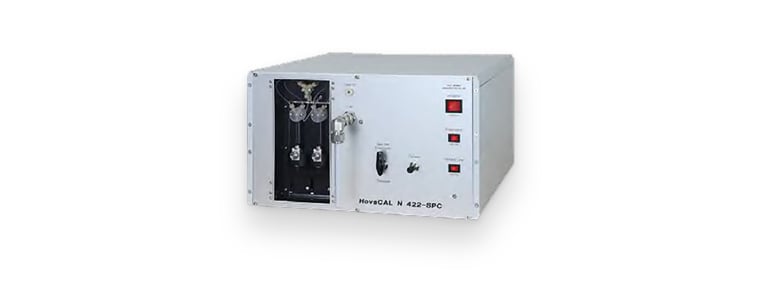Tecan uses cookies to improve our website. By continuing to browse our website, you accept our cookie policy.
Tecan uses cookies to improve our website. By continuing to browse our website, you accept our cookie policy.

Continuous emission monitoring systems that detect gases or particulate matter concentrations are important in various industrial settings, where they are used to ensure that potential sources of pollutants comply with environmental regulations. Inspire Analytical Systems (IAS) is a German manufacturer of calibration gas generators for analyzers and sensors that offer highly precise and continuous monitoring of gas emissions.
Monitoring the concentrations of gases – particularly toxic pollutants emitted from industrial processes – is a principal health and safety measure. Waste incineration plants, for example, liberate flue gas, and require a gas analyzer to regularly check the emission levels at the end of the incineration process. However, the use of gas analyzers and sensors does not stop at environmental applications. Fabian Kories, CTO at IAS, is responsible for the development of calibration gas generators, and explained: “All analyzers and sensors need to be calibrated, requiring the precise generation of reference gases across a broad range of concentrations. We provide a device – the HovaCAL® – which does exactly that, offering flexible generation of calibration gases, such as volatile organic compounds (VOC) and airborne molecular contaminants (AMC), at concentrations as low as parts per billion. Although a majority of our customers are in industrial emissions monitoring, this is shifting to include other markets, as pollutants are now constantly being monitored in offices, public spaces and manufacturing processes. We are also seeing increasing interest from the healthcare sector, where using breath as a tool for non-invasive diagnosis and monitoring is an exciting area of research. For example, there are ongoing studies to find out if sensors developed with the HovaCAL can be used to monitor the level of anesthesia just from a patient’s breath, allowing dynamic adjustments during an operation.”
The HovaCAL was originally developed to allow calibration of standard emission monitoring gases, including H2O, HCl, NH3, HF and HgCl2. However, the growing range of applications for gas sensors is requiring calibration gas generators to become ever-more flexible to meet the increasingly diverse needs of the market, creating new challenges for manufacturers. Fabian commented: “Much of the focus when developing our devices was the robustness of the automated pump. The HovaCAL operates by feeding a liquid, such as an organic solvent or aqueous solution, into an evaporator at a rate of microliters to nanoliters per second, which then mixes with a dry gas to completely evaporate the liquid and provide a calibration gas. Unlike fluid monitoring applications, we cannot get away with using peristaltic pumps for this, as they are not resistant to the caustic and organic solvents we use. We therefore use a syringe pump of the type normally developed for the medical industry, which uses PTFE and glass parts that remain inert and have no ‘memory effects’, making the quality a top priority.”
Tecan has been an excellent partner in this, from understanding the specific problems and challenges during the development process, to the day-to-day support the company offers.
“A couple of years ago, our long-term supplier discontinued the syringe pump we were using, and we took this as a good opportunity to explore what was available on the market,” Fabian continued. “It was almost perfect timing, because we were already in the process of redeveloping the HovaCAL. After speaking to several suppliers, we chose to partner with Tecan, because the company’s pumps offered the best performance and broadest range of liquid flows suitable for our applications. When designing a system, we always consider the highest and lowest flow rates that can be attained without resulting in fluctuations and, with the Cavro® Centris pump, we’re able to achieve higher precision for a broader range of volumes than our old pumps. It was very straightforward to integrate the Cavro Centris during the reengineering of our product, as the commands are intuitive and similar to those of other pumps.”
 The Cavro Centris pump is central to the HovaCAL device
The Cavro Centris pump is central to the HovaCAL device
The redevelopment of the HovaCAL has also opened up opportunities for use in even more application areas. “Our portfolio has now expanded to include industry-specific devices to suit a variety of settings. For example, a technician in a waste incineration plant is likely to want a portable device for in situ sensor calibration, whereas the size is less relevant to laboratory settings in universities or production plants. Tecan has been an excellent partner in this, from understanding the specific problems and challenges during the development process, to the day-to-day support the company offers. We were most impressed by how quickly the team was able to supply us with pumps to test for our many applications. Their immediate and responsive assistance, along with suggestions and technical advice, allowed us to implement and incorporate these pumps into our devices very quickly. We look forward to the possibility of future pump iterations that we can adopt to constantly improve our equipment,” concluded Fabian.
For Research Use Only. Not for use in diagnostic procedures.
To find out more about Cavro syringe pumps, go to partnering.tecan.com/cavro-liquid-handling-pumps
To learn more about IAS, visit www.hovacal.de/en/